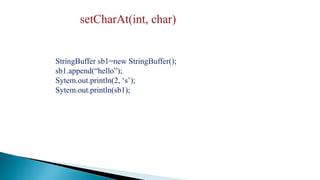StringBuffer.pptx
- 2. A string buffer implements a mutable sequence of characters. A string buffer is like a String, but can be modified. At any point in time it contains some particular sequence of characters, but the length and content of the sequence can be changed through certain method calls. Every string buffer has a capacity. When the length of the character sequence contained in the string buffer exceed the capacity, it is automatically made larger.
- 3. String buffers are used by the compiler to implement the binary string concatenation operator +. For example: x = "a" + 4 + "c" is compiled to the equivalent of: x = new StringBuffer().append("a").append(4). append("c") .toString()
- 4. StringBuffer is a peer class of String that provides much of the functionality of strings. String represents fixed-length, immutable character sequences. In contrast, StringBuffer represents growable and writeable character sequences. StringBuffer may have characters and substrings inserted in the middle or appended to the end. StringBuffer will automatically grow to make room for such additions.
- 5. StringBuffer defines these four constructors: âĶ StringBuffer( ) âĶ StringBuffer(int size) âĶ StringBuffer(String str) âĶ StringBuffer(CharSequence chars) The default constructor reserves room for 16 characters without reallocation. By allocating room for a few extra characters(size +16), StringBuffer reduces the number of reallocations that take place.
- 6. StringBuffer sb = new StringBuffer(); System.out.println(sb.capacity()); //default capacity -16 StringBuffer sb = new StringBuffer(65); System.out.println(sb.capacity()); StringBuffer sb = new StringBuffer(âAâ); System.out.println(sb.capacity()); StringBuffer sb = new StringBuffer('A'); System.out.println(sb.capacity());
- 7. length( ) and capacity( ) The current length of a StringBuffer can be found via the length( ) method, while the total allocated capacity can be found through the capacity( ) method. int length( ) int capacity( ) Example: class StringBufferDemo { public static void main(String args[]) { StringBuffer sb = new StringBuffer(âHello"); System.out.println("length = " + sb.length()); ---5 System.out.println("capacity = " + sb.capacity());--16 } }
- 8. StringBuffer sb1=new StringBuffer(); System.out.println(sb1.capacity()); System.out.println(sb1.length()); StringBuffer sb1=new StringBuffer(âBANASTHALIâ); System.out.println(sb1.capacity()); System.out.println(sb1.length());
- 9. If we want to preallocate room for a certain number of characters after a StringBuffer has been constructed, we can use ensureCapacity( ) to set the size of the buffer. This is useful if we know in advance that we will be appending a large number of small strings to a StringBuffer. void ensureCapacity(int capacity) Here, capacity specifies the size of the buffer.
- 10. used to set the length of the buffer within a StringBuffer object. void setLength(int length) Here, length specifies the length of the buffer. When we increase the size of the buffer, null characters are added to the end of the existing buffer. If we call setLength( ) with a value less than the current value returned by length( ), then the characters stored beyond the new length will be lost.
- 12. The append( ) method concatenates the string representation of any other type of data to the end of the invoking StringBuffer object. It has several overloaded versions. âĶ StringBuffer append(String str) âĶ StringBuffer append(int num) âĶ StringBuffer append(Object obj)
- 14. class appendDemo { public static void main(String args[]) { String s; int a = 42; StringBuffer sb = new StringBuffer(40); s = sb.append("a = ").append(a).append("!") .toString(); System.out.println(s); } }
- 15. The insert( ) method inserts one string into another. It is overloaded to accept values of all the simple types, plus Strings, Objects, and CharSequences. This string is then inserted into the invoking StringBuffer object. âĶ StringBuffer insert(int index, String str) âĶ StringBuffer insert(int index, char ch) âĶ StringBuffer insert(int index, Object obj)
- 16. class insertDemo { public static void main(String args[]) { StringBuffer sb = new StringBuffer("I Java!"); sb.insert(2, "like "); System.out.println(sb); } }
- 17. Used to reverse the characters within a StringBuffer object. This method returns the reversed object on which it was called. StringBuffer reverse() Example: class ReverseDemo { public static void main(String args[]) { StringBuffer s = new StringBuffer(âBanana"); System.out.println(s); s.reverse(); System.out.println(s); } }
- 18. Used to delete characters within a StringBuffer. StringBuffer delete(int startIndex, int endIndex) StringBuffer deleteCharAt(int index) The delete( ) method deletes a sequence of characters from the invoking object (from startIndex to endIndex-1). The deleteCharAt( ) method deletes the character at the specified index. It returns the resulting StringBuffer object.
- 19. class deleteDemo { public static void main(String args[]) { StringBuffer sb = new StringBuffer(âShe is not a good girl.â); sb.delete(7, 11); System.out.println("After delete: " + sb); sb.deleteCharAt(7); System.out.println("After deleteCharAt: " + sb); } }
- 20. Used to replace one set of characters with another set inside a StringBuffer object. StringBuffer replace(int startIndex, int endIndex, String str) The substring being replaced is specified by the indexes startIndex and endIndex. Thus, the substring at startIndex through endIndexâ1 is replaced. The replacement string is passed in str. The resulting StringBuffer object is returned.
- 21. class replaceDemo { public static void main(String args[]) { StringBuffer sb = new StringBuffer("This is a test."); sb.replace(5, 7, "was"); System.out.println("After replace: " + sb); } }
- 22. StringBuffer sb1=new StringBuffer(); sb1.append(âhelloâ); Sytem.out.println(2, âsâ); Sytem.out.println(sb1);


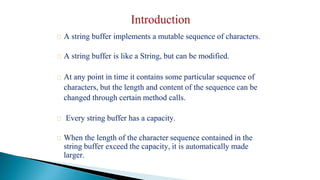
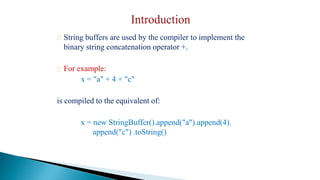
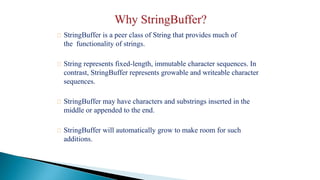
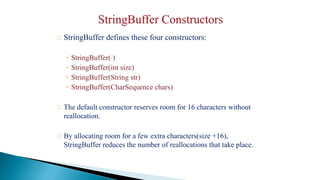
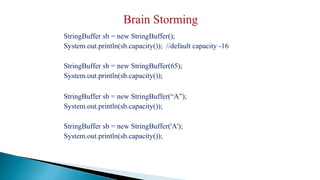
![length( ) and capacity( )
The current length of a StringBuffer can be found via the length( ) method,
while the total allocated capacity can be found through the capacity( )
method.
int length( )
int capacity( )
Example:
class StringBufferDemo {
public static void main(String args[]) {
StringBuffer sb = new StringBuffer(âHello");
System.out.println("length = " + sb.length()); ---5
System.out.println("capacity = " + sb.capacity());--16
}
}](https://image.slidesharecdn.com/stringbuffer-230812090154-6d0a1fd9/85/StringBuffer-pptx-7-320.jpg)
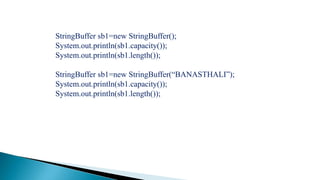
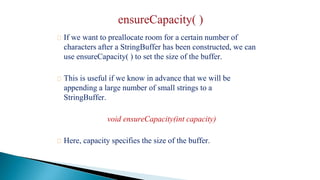

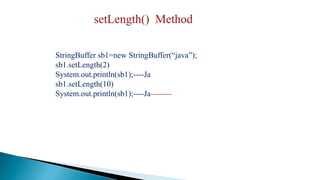
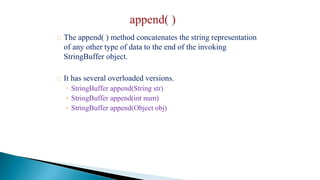

![class appendDemo {
public static void main(String args[]) {
String s;
int a = 42;
StringBuffer sb = new StringBuffer(40);
s = sb.append("a = ").append(a).append("!")
.toString();
System.out.println(s);
}
}](https://image.slidesharecdn.com/stringbuffer-230812090154-6d0a1fd9/85/StringBuffer-pptx-14-320.jpg)

![class insertDemo {
public static void main(String args[]) {
StringBuffer sb = new StringBuffer("I
Java!"); sb.insert(2, "like ");
System.out.println(sb);
}
}](https://image.slidesharecdn.com/stringbuffer-230812090154-6d0a1fd9/85/StringBuffer-pptx-16-320.jpg)
![Used to reverse the characters within a StringBuffer object.
This method returns the reversed object on which it was called.
StringBuffer reverse()
Example:
class ReverseDemo {
public static void main(String args[]) {
StringBuffer s = new StringBuffer(âBanana");
System.out.println(s);
s.reverse();
System.out.println(s);
}
}](https://image.slidesharecdn.com/stringbuffer-230812090154-6d0a1fd9/85/StringBuffer-pptx-17-320.jpg)

![class deleteDemo {
public static void main(String args[]) {
StringBuffer sb = new StringBuffer(âShe is not a good girl.â);
sb.delete(7, 11);
System.out.println("After delete: " + sb);
sb.deleteCharAt(7);
System.out.println("After deleteCharAt: " + sb);
}
}](https://image.slidesharecdn.com/stringbuffer-230812090154-6d0a1fd9/85/StringBuffer-pptx-19-320.jpg)

![class replaceDemo {
public static void main(String args[]) {
StringBuffer sb = new StringBuffer("This is a test.");
sb.replace(5, 7, "was");
System.out.println("After replace: " + sb);
}
}](https://image.slidesharecdn.com/stringbuffer-230812090154-6d0a1fd9/85/StringBuffer-pptx-21-320.jpg)
